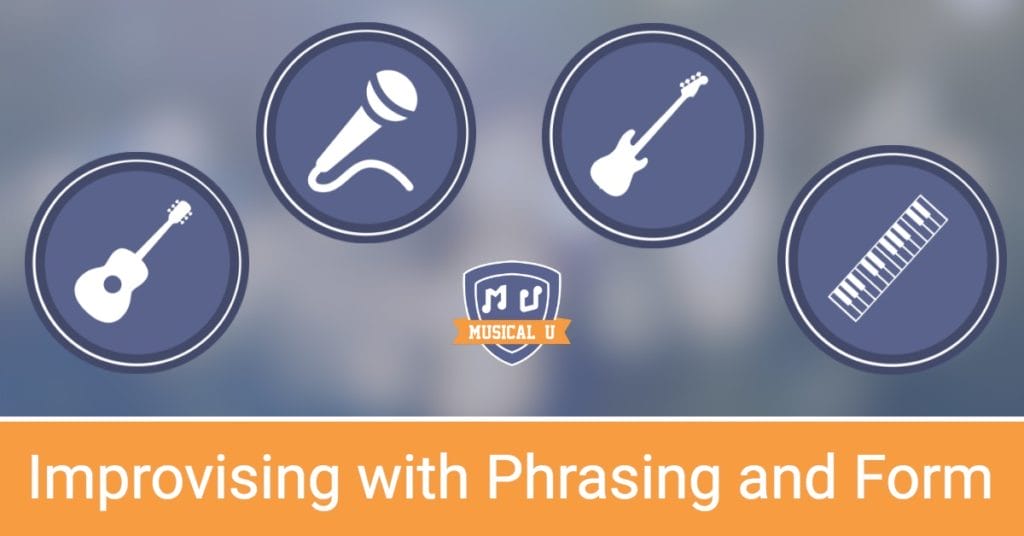Who are your favorite improvisers? Why is it that we can listen to their recorded solos over and over? Why do aspiring soloists and scholars transcribe and memorize every detail? What gives these spontaneous creations the same long-lasting meaning and greatness that we might ascribe to a Beethoven symphony?
Then, we look at our own improvisations.
Maybe we’ve learned some good licks or riffs. Or figured out which scale patterns work best over that chord progression. It was fun at first, but after a while it all seems shapeless, mechanical. Is there something wrong with us?
Were we condemned to be born as mere mortals, never to enjoy the crucial spark of inspiration and talent exuded in the eternal musical expressions of our improvising hero-gods?
The good news: now that we know that all the hours of practicing licks, riffs, and scales are not enough, there really is another step to take to make your improvs sing.
Just as we shape our verbal communication with words, phrases, sentences, questions, answers – and larger structures such as paragraphs, stories, topics – we can shape our musical expressions with phrasing and form.
Phrases are short sections of melody with a beginning, middle, and end. While meaningful in and of themselves, they’re too short to make a whole piece of music. They need to join together with other phrases in larger sections and forms to make that happen. As improvisers, an understanding of phrasing and form gives us to shape our solos into whole musical works – much like a composer or a songwriter.
In this month’s Instrument Packs Musical U’s Resident Pros for guitar, piano, and bass introduce the concepts of phrasing and form – with videos, PDFs, and MP3s that lay out structured sequences of exercises to help you mold and shape your improv into the satisfying, whole musical expression that you crave.
Piano
Resident Pro Sara Campbell loves songs. In this resource pack, Sara shows you how you can deploy the standard structure of popular songs to literally improvise a new song on the spot. Also, how improvisation can be used as a compositional tool within song form to create new and lasting piano instrumentals with shape, depth, and meaning.
Including:
- Song Form and Structure: How using song form can assist you in telling a story.
- How to expand your melodic ideas through phrasing, structure, and sequences.
- Improvisation Exercise: A chord chart and piano chart that will help you develop different melodies for various parts of a song.
- Playalong MP3 backing tracks with a beautiful song-form chord progression in two different keys – over which you improvise your own melodies.
Rather than just improvising a solo on someone else’s song, improvise the entire song yourself! And, in the process, learn how to shape your musical expression with form.
Guitar
Like any trip, melodies gain more meaning when they have a destination. Resident Pro Dylan Welsh shows how to choose your musical “target” on your guitar, taking you and your listeners on a memorable musical journey.
Including:
- Definitions, context, and examples of musical phrasing.
- Strategies to relate music to conversation, in order to help you bridge the gap between the two in your mind and ears.
- A trick Dylan teaches his private students, regarding “target tones” and setting up intentional notes to focus each phrase around.
- A strategy that combines phrasing and musical conversation in order to keep your solos interesting and engaging over long periods of time.
- Exercises, MP3s, and a PDF to learn phrasing and musical conversation in your own practice room.
Learn how to guide your improvs to their destination, and “speak” their story in Dylan’s phrasing and form workshop.
Bass
Many beginning improvisers mistakenly believe that you have to reinvent the wheel each time you take a solo. Resident Pro Steve Lawson Improv demonstrates that improvisation is about bringing together your decision-making process, and your (bass-specific) musical vocabulary, not inventing new things every time you play.
Including:
- How to get your improviser’s attitude together before you start playing.
- How to fit in with a genre with stylistic and idiomatic improvisation
- How to expand a whole solo from just one note
- Other improv techniques that maintain continuity and cohesiveness
- Beautiful backing tracks for your practicing pleasure
Whether you’re frying up some funk or plunking down some pentatonics, learn how to expand your creativity without sounding like a musical “alien” with Steve’s take on improvisational vocabulary.
Coming up next month…
Intervals – the space between two notes – are one of the most crucial building blocks in music. Yet often times people find interval training to be tedious and difficult. But like all ear training, getting your instrument into the act makes it more fun, meaningful, relevant, and effective.
Next month we’ll learn how intervals can be explored effectively and enjoyably on our instruments. Our resident pros show you how and where to learn intervals, and expand them into the music we love.
Interested in getting access to these resources and much more, with an Instrument Pack membership? Just choose that option during checkout when you join Musical U, or upgrade your existing membership to get instant access!







